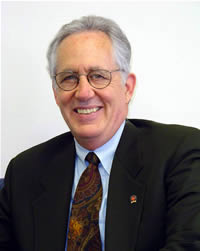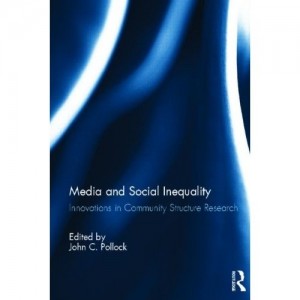EWING, NJ … After working for over 20 years with TCNJ students on multiple projects examining the impact of society on media, communication studies professor John Pollock assembled a collection of work by leading scholars to explore new directions in the subfield, a book titled Media and Social Inequality: Innovations in Community Structure Research (Routledge, 2013). Contrary to traditional efforts examining the impact of media on society, the “community structure” subfield instead endeavors to measure the reverse: the impact of society on media, an effort to link city or national demographic variations with differences in reporting on critical social and political issues.

Two of the chapters represent work completed at TCNJ: Chapter One – Introduction: Social Inequality and Media (including a case study of nationwide coverage of the “Occupy” movement), and Chapter Six – Nationwide Newspaper Coverage of Universal Health Care: A Community Structure Approach (co-authored with TCNJ alumni Kristen Kiernicki and Patrick Lavery). Moving beyond previous case studies focused on one or two cities or a single state, and beyond explanations rooted in the attitudes of journalists or the organizational patterns of news work and news organizations, TCNJ community structure studies adopt a “macro” perspective by designing original nationwide US samples of multiple(21-28) metropolitan papers to compare systematic differences in community characteristics/demographics with variations in coverage of critical issues. Relying on many TCNJ-generated published articles and chapters, as well as over one hundred refereed conference papers (co-authored with TCNJ students) presented at national professional conferences, the TCNJ chapter case studies explore both critical public issues and varied measures of social inequality, ranging from unequal distributions of members of different groups (generations, position in the lifecycle – families with children of different ages, belief systems) through historically marginalized or underserved populations (African Americans, Hispanics) to population segments disadvantaged through residential or economic circumstances (high crime rates, unemployment, poverty levels).
A “Vulnerability” Pattern
A key question Pollock and his students often explore is: How often do media act as “guard dogs” of privilege, reinforcing the values and interests of social, political, and economic elites; and by contrast, how often do media “mirror” the interests of the most “vulnerable” segments of our society? More specifically, how does social inequality affect the way media report on social and political change?
Reaching beyond previous research, Pollock’s scholarship employs a sophisticated content analysis measure of “coverage direction” combining traditional measures of newspaper content “direction” (favorable, unfavorable, balanced/neutral) with more modern measures of article “prominence” (placement – proximity to the first page of a newspaper, headline length, article length, number of graphics/photos) to yield a composite measure of media issue “projection” called a “Media Vector”. This modern, sensitive content measure has yielded substantial evidence that, contrary to traditional findings suggesting media often function as elite “guard dogs”, media can often act as “mirrors” of the interests and values of the socially disadvantaged, for example:
- The larger the percent below the poverty level in a city, the more favorable the coverage of a Patients’ Bill of Rights (more equitable health rights), and the less favorable the coverage of capital punishment.
- Similarly, the larger the proportion of Hispanics (among the most underinsured US residents) in a city, the more favorable the metropolitan media coverage of universal health care.
- (Completely contrary to conventional wisdom, multiple nationwide studies consistently reveal that) The larger the percent Catholics in a city, the more (!) favorable the coverage of legalization of same sex marriage and same sex adoption.
- Similarly, the higher a city’s score on a “Gay Market Index” (measuring the number of businesses and non-profits marketing to gays in a city), the more favorable the coverage of same sex marriage.
- The larger the percent Mainline Protestants in a city, the more favorable the coverage of the “Occupy” movement prior to the eviction of protesters from Manhattan’s Zuccotti Park.
- The larger the percent of families with children under five years old in a city, the more favorable the coverage of the “Occupy” movement after the eviction of protesters from Zuccotti Park.
In addition to documenting a “vulnerability” pattern linking city characteristics and variations in media coverage, Pollock’s work has also validated three other patterns: “buffer,” “violated buffer,” and “stakeholder.”

“Buffer,” “Violated Buffer,” and “Stakeholder” Patterns
The “buffer” pattern links higher levels of privilege (education, family income, occupational status, health care access) to relatively “benevolent” coverage honoring human rights claims. For example, the higher the percent college educated or family incomes of 100,000+ in a city, the more favorable the coverage of embryonic stem cell research or the legalization of physician-assisted suicide.
The “violated buffer” pattern links higher levels of privilege with coverage unfavorable toward biological threats or perceived threats to a cherished way of life. For example, the higher the educational and family income levels in a city, the less favorable the coverage of those with HIV/AIDS when Magic Johnson made his HIV-positive announcement, suggesting fear of a biological threat. Similar, in the late 1990s, the higher family income levels in a city, the less favorable the coverage of women in combat (perhaps a threat to a traditional, cherished way of life).
The “stakeholder” pattern links higher proportions of specific groups in a city with more favorable coverage of their group concerns. For example, the higher the percent families with late teenage (16-18) children in a city, the “less” media support for gun control. Since late teens and early twenties age segments are the most likely victims of violent crime, the finding is paradoxical. Perhaps many parents of “at risk” children adopt a “vigilante” perspective, distrusting police assistance, supporting arming their own “good” children in the face of armed “bad guys.”
Finding the previous patterns in multiple nationwide studies, it is intriguing to speculate about the reasons for the results: How are precise portions of different groups linked to media coverage? What mechanisms connect different community structures and variations in coverage of critical issues? Pollock and his students continue to pursue answers to questions raised by community structure studies that yield surprising findings and provoke lively discussion.
